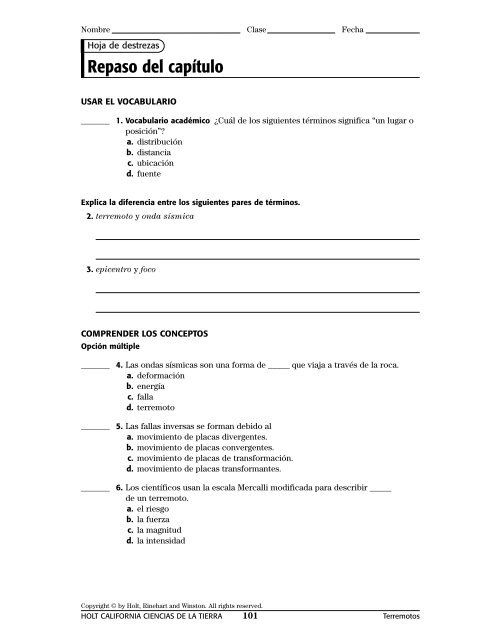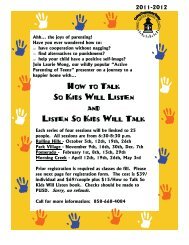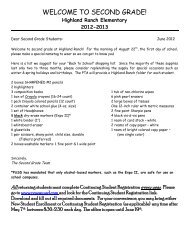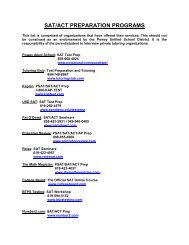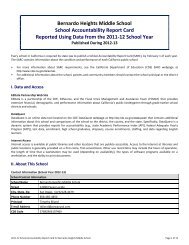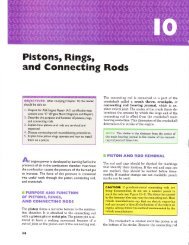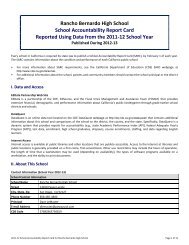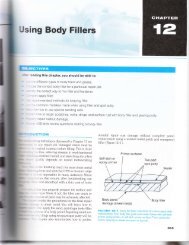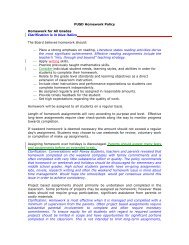Repaso del capítulo
Repaso del capítulo
Repaso del capítulo
Create successful ePaper yourself
Turn your PDF publications into a flip-book with our unique Google optimized e-Paper software.
Nombre Clase Fecha<br />
Hoja de destrezas<br />
<strong>Repaso</strong> <strong>del</strong> <strong>capítulo</strong><br />
USAR EL VOCABULARIO<br />
_______ 1. Vocabulario académico ¿Cuál de los siguientes términos significa “un lugar o<br />
posición”?<br />
a. distribución<br />
b. distancia<br />
c. ubicación<br />
d. fuente<br />
Explica la diferencia entre los siguientes pares de términos.<br />
2. terremoto y onda sísmica<br />
3. epicentro y foco<br />
COMPRENDER LOS CONCEPTOS<br />
Opción múltiple<br />
_______ 4. Las ondas sísmicas son una forma de _____ que viaja a través de la roca.<br />
a. deformación<br />
b. energía<br />
c. falla<br />
d. terremoto<br />
_______ 5. Las fallas inversas se forman debido al<br />
a. movimiento de placas divergentes.<br />
b. movimiento de placas convergentes.<br />
c. movimiento de placas de transformación.<br />
d. movimiento de placas transformantes.<br />
_______ 6. Los científicos usan la escala Mercalli modificada para describir _____<br />
de un terremoto.<br />
a. el riesgo<br />
b. la fuerza<br />
c. la magnitud<br />
d. la intensidad<br />
Copyright © by Holt, Rinehart and Winston. All rights reserved.<br />
HOLT CALIFORNIA CIENCIAS DE LA TIERRA 101 Terremotos
Nombre Clase Fecha<br />
<strong>Repaso</strong> <strong>del</strong> <strong>capítulo</strong> (continuación)<br />
_______ 7. _____ es el temblor <strong>del</strong> suelo provocado por un movimiento súbito a lo largo<br />
de una grieta de la superficie terrestre.<br />
a. Una falla<br />
b. Un terremoto<br />
c. Un epicentro<br />
d. Un tsunami<br />
Respuesta breve<br />
8. Hacer una lista Explica cómo las fuerzas tectónicas crearon la zona de la falla de San<br />
Andrés. ¿Qué tipo de falla es típica de esta zona de fallas?<br />
9. Resumir Describe el método que usan los científicos para ubicar el epicentro de<br />
un terremoto.<br />
10. Comparar ¿En qué se diferencia la escala de Richter de la escala de magnitud<br />
momento?<br />
11. Identificar ¿Cómo respalda la ubicación de los terremotos la teoría de la tectónica de<br />
placas?<br />
12. Describir ¿Cómo describe la intensidad de un terremoto la escala Mercalli<br />
modificada?<br />
13. Describir Explica cómo los terremotos submarinos provocan tsunamis.<br />
Copyright © by Holt, Rinehart and Winston. All rights reserved.<br />
HOLT CALIFORNIA CIENCIAS DE LA TIERRA 102 Terremotos
Nombre Clase Fecha<br />
<strong>Repaso</strong> <strong>del</strong> <strong>capítulo</strong> (continuación)<br />
14. Identificar ¿Cuáles son los cuatro factores que afectan a la cantidad de daños<br />
ocasionados por un terremoto?<br />
15. Analizar ¿De qué manera los terremotos y los tsunamis cambian los hábitats<br />
humanos y de la vida silvestre?<br />
16. Analizar ¿De qué manera el rebote elástico provoca la transferencia de energía?<br />
INTERPRETAR GRÁFICAS<br />
Consulta el diagrama para contestar las siguientes dos preguntas.<br />
17. Aplicar ¿Que tipo de falla muestra la ilustración?<br />
18. Aplicar ¿Qué tipo de movimiento de placas produce este tipo de falla?<br />
DESTREZAS DE REDACCIÓN<br />
Foco<br />
19. Explicar ideas En una hoja aparte, escribe un ensayo en el que expliques claramente<br />
la relación entre los terremotos y la tectónica de placas a un estudiante de tercer<br />
grado. Tu ensayo debe proponer una tesis e incluir pruebas que respalden tus ideas.<br />
Finalmente, asegúrate de que tu ensayo tenga una conclusión.<br />
Copyright © by Holt, Rinehart and Winston. All rights reserved.<br />
Epicentro<br />
HOLT CALIFORNIA CIENCIAS DE LA TIERRA 103 Terremotos
Nombre Clase Fecha<br />
<strong>Repaso</strong> <strong>del</strong> <strong>capítulo</strong> (continuación)<br />
RAZONAMIENTO CRÍTICO<br />
20. Mapa de conceptos Haz un mapa de conceptos con los siguientes términos: foco,<br />
epicentro, sismograma, ondas sísmicas, ondas P y ondas S.<br />
Copyright © by Holt, Rinehart and Winston. All rights reserved.<br />
HOLT CALIFORNIA CIENCIAS DE LA TIERRA 104 Terremotos
Nombre Clase Fecha<br />
<strong>Repaso</strong> <strong>del</strong> <strong>capítulo</strong> (continuación)<br />
21. Identificar relaciones ¿Es más probable que se produzca un gran terremoto a<br />
lo largo de una falla donde recientemente hubo pocos terremotos o a lo largo de<br />
una falla donde recientemente se produjeron varios terremotos menores? Explica<br />
tu respuesta.<br />
22. Aplicar conceptos Japón está ubicado cerca de un punto donde convergen<br />
tres placas tectónicas. ¿Cuál crees que es el nivel de riesgo sísmico en Japón?<br />
Explica tu respuesta.<br />
23. Aplicar conceptos Si estás en un automóvil durante un terremoto y estás en<br />
un lugar abierto, ¿lo más seguro es permanecer dentro <strong>del</strong> automóvil? ¿Se te<br />
ocurre alguna situación en la que sería mejor abandonar el automóvil durante<br />
un terremoto? Explica tu respuesta.<br />
24. Identificar relaciones Usas gelatina para simular roca en un experimento en el que<br />
estás investigando la manera en que las diferentes ondas sísmicas afectan a la roca.<br />
¿Qué es lo que hace que tu mo<strong>del</strong>o de gelatina sea limitado?<br />
25. Identificar relaciones ¿Es probable que un terremoto en las montañas Rocallosas de<br />
Colorado forme un tsunami? Explica tu repuesta.<br />
Copyright © by Holt, Rinehart and Winston. All rights reserved.<br />
HOLT CALIFORNIA CIENCIAS DE LA TIERRA 105 Terremotos
Nombre Clase Fecha<br />
<strong>Repaso</strong> <strong>del</strong> <strong>capítulo</strong> (continuación)<br />
26. Analizar las consecuencias ¿Cómo puede un terremoto que ocurre debajo <strong>del</strong> océano y<br />
lejos de un área poblada causar daños materiales y pérdida de vidas humanas?<br />
INTERPRETAR GRÁFICAS<br />
Consulta el mapa para contestar las siguientes tres preguntas.<br />
Seattle<br />
San Francisco<br />
Albuquerque<br />
Sioux City<br />
27. Aplicar conceptos ¿Dónde estaba el epicentro <strong>del</strong> terremoto? Explica cómo lo determinaste.<br />
28. Identificar relaciones Si las ondas P viajan a una velocidad de 6.1 km/s, ¿aproximadamente<br />
cuánto tiempo tardaron las ondas P en llegar a Albuquerque?<br />
(Pista: consulta la escala <strong>del</strong> mapa).<br />
Copyright © by Holt, Rinehart and Winston. All rights reserved.<br />
500 KM<br />
HOLT CALIFORNIA CIENCIAS DE LA TIERRA 106 Terremotos<br />
0<br />
0<br />
500 Millas
Nombre Clase Fecha<br />
<strong>Repaso</strong> <strong>del</strong> <strong>capítulo</strong> (continuación)<br />
29. Identificar relaciones Si sólo estuvieran disponibles los datos <strong>del</strong> sismógrafo de<br />
Seattle y Albuquerque, ¿cuántos lugares podrías identificar como el epicentro?<br />
DESTREZAS MATEMÁTICAS<br />
30. Convertir Las ondas S viajan aproximadamente al 60% de velocidad de las ondas P.<br />
Las ondas P viajan a unos 6.1 km/s. ¿Cuál es la velocidad de las ondas S? Muestra tu<br />
trabajo en el espacio en blanco.<br />
DESAFÍO<br />
31. Inferir Dos terremotos de magnitudes similares ocurren en dos partes distintas <strong>del</strong><br />
mundo. Un terremoto se cobra muchas vidas y provoca muchos daños materiales, y<br />
el otro causa muy pocos daños materiales y ninguna muerte. ¿Qué podría explicar la<br />
diferencia en la cantidad de daños ocasionados por los terremotos?<br />
Copyright © by Holt, Rinehart and Winston. All rights reserved.<br />
HOLT CALIFORNIA CIENCIAS DE LA TIERRA 107 Terremotos
TEACHER RESOURCES<br />
4. Sample answer: A mass damper is<br />
a computer-controlled weight that<br />
is placed in the roof of a building to<br />
counteract the building’s movement.<br />
Base isolators at the base of the<br />
building absorb seismic waves and<br />
prevent the waves from traveling<br />
through the building. Steel cross<br />
braces counteract pressure that<br />
pushes and pulls at the side of a<br />
building during an earthquake. Pipes<br />
that have flexible joints are able to<br />
bend and twist during an earthquake.<br />
5. When large earthquakes happen, a<br />
huge amount of energy is released<br />
as seismic waves. Many smaller<br />
earthquakes are required to release<br />
this same amount of energy as seismic<br />
waves.<br />
6. Earthquakes can damage buildings,<br />
bridges, and roads; start fires; and<br />
cause landslides. Tsunamis can<br />
generate large waves that flood large<br />
areas of coastline, causing large<br />
amounts of damage and loss of life.<br />
7. Sample answer: Large earthquakes are<br />
less common than small earthquakes<br />
because greater movement must take<br />
place along a fault to generate the<br />
large amounts of energy released in a<br />
large earthquake.<br />
8. No, the hypothesis gives only a<br />
20% likelihood of a magnitude 7.0<br />
earthquake. Therefore, the likelihood<br />
that the earthquake would not happen<br />
was much higher than the likelihood<br />
that it would happen.<br />
9. 1 17 134 152<br />
10. 18 10 180<br />
11. 325 km/30 min (325 2) km/60 min<br />
650 km/h<br />
12. A hypothesis that might explain this<br />
phenomenon is that animals may<br />
possess more acute hearing and other<br />
senses that enable them to hear or<br />
feel Earth’s vibrations. To test this<br />
hypothesis, conditions similar to those<br />
that exist before a tsunami would have<br />
to be artificially created to determine<br />
animals’ reactions.<br />
Copyright © by Holt, Rinehart and Winston. All rights reserved.<br />
Chapter Review<br />
1. C<br />
2. Sample answer: An earthquake is<br />
ground movement caused by seismic<br />
waves. A seismic wave is energy that<br />
travels through rock.<br />
3. Sample answer: An epicenter is the<br />
point on Earth’s surface directly above<br />
an earthquake’s starting point. A focus<br />
is the point inside Earth where an<br />
earthquake begins.<br />
4. B<br />
5. B<br />
6. D<br />
7. B<br />
8. The San Andreas fault zone is located<br />
at a transform boundary, where two<br />
plates are grinding past one another<br />
horizontally. As the rocks grind past<br />
one another, shear stress causes rock<br />
to break into a series of blocks. The<br />
blocks form a series of strike-slip<br />
faults—the typical fault type along the<br />
San Andreas fault.<br />
9. Scientists use the differences in<br />
the arrival times of P waves and S<br />
waves to find how far seismic waves<br />
have traveled. Then, they locate the<br />
earthquake epicenter by drawing<br />
circles around three seismometer<br />
stations. The radius of each circle<br />
represents the distance to the<br />
epicenter. The point where the circles<br />
intersect is the earthquake’s epicenter.<br />
10. The Richter scale measures the<br />
ground motion from an earthquake<br />
and adjusts for distance to find the<br />
earthquake’s magnitude. Moment<br />
magnitude is based on the area of the<br />
fault that moves, the average distance<br />
the fault blocks move, and the rigidity<br />
of the rocks in the fault zone.<br />
11. Most earthquakes occur at tectonic<br />
plate boundaries, where plate motion<br />
is occurring.<br />
12. The Modified Mercalli scale describes<br />
earthquake intensity by the damaging<br />
effects of the earthquake and by how<br />
the earthquake is felt by people.<br />
Holt California Earth Science 126 Earthquakes
TEACHER RESOURCES<br />
13. Tsunamis form when an undersea<br />
earthquake causes a vertical<br />
movement of the sea floor. This<br />
movement displaces an enormous<br />
volume of water, which creates a<br />
series of tsunami waves.<br />
14. Four factors that affect the intensity<br />
of an earthquake are earthquake<br />
magnitude, distance from the<br />
earthquake epicenter, local geology,<br />
and building construction.<br />
15. Earthquakes can damage buildings,<br />
bridges, and roads; start fires; and<br />
cause landslides. Tsunamis can<br />
generate large waves that flood large<br />
areas of coastline, causing large<br />
amounts of damage and loss of life.<br />
16. When stress is suddenly released from<br />
elastically deformed rock, the rock<br />
snaps back to its original shape and<br />
size, which releases energy in the form<br />
of seismic waves.<br />
17. a normal fault<br />
18. divergent plate motion<br />
19. Answers may vary but should cover all<br />
requirements stated in the question.<br />
20. An answer to this exercise can be<br />
found at the end of the Teacher<br />
Edition.<br />
21. Answers may vary. Because few<br />
earthquakes have happened recently<br />
along one fault, there may be a<br />
seismic gap. A large earthquake may<br />
fill this gap. Alternatively, the small<br />
earthquakes may indicate a high<br />
seismicity level, which may make a<br />
large earthquake more likely.<br />
22. Because most earthquakes occur<br />
at tectonic plate boundaries, the<br />
earthquake-hazard level in Japan is<br />
probably high.<br />
23. Answers may vary. Sample answer:<br />
You might want to leave your car if it<br />
was stranded on or beneath a highway<br />
overpass.<br />
24. A piece of gelatin is too small to show<br />
the difference in the speed of P waves<br />
and S waves, and it does not have the<br />
same properties as rock.<br />
25. An earthquake in the Rocky Mountains<br />
of Colorado would not be likely to<br />
form a tsunami, because there is no<br />
large body of water to displace.<br />
Copyright © by Holt, Rinehart and Winston. All rights reserved.<br />
26. An undersea earthquake can cause a<br />
tsunami. Tsunamis can cause property<br />
damage and loss of life.<br />
27. San Francisco was the epicenter of<br />
the earthquake. The three circles<br />
intersected at this point.<br />
28. a little more than 2 min; 13/16 inch <br />
812 km; 812 km 6.1 km/s 133 s;<br />
133s 60 s/min 2.2 min<br />
29. Two locations could be the possible<br />
epicenter of the earthquake.<br />
30. 6.1 km/s 0.60 3.66 km/s<br />
31. Answers may vary. The local geology<br />
in the area where each earthquake<br />
took place may have been quite<br />
different. The construction materials<br />
used in buildings and homes may also<br />
have been quite different. In addition,<br />
people may have been more prepared<br />
for an earthquake in one area than<br />
another.<br />
Section Quizzes<br />
SECTION: WHAT ARE<br />
EARTHQUAKES?<br />
1. B<br />
2. E<br />
3. D<br />
4. C<br />
5. A<br />
6. A<br />
7. D<br />
8. C<br />
9. A<br />
SECTION: EARTHQUAKE<br />
MEASUREMENT<br />
1. D<br />
2. A<br />
3. F<br />
4. C<br />
5. B<br />
6. E<br />
7. D<br />
8. A<br />
9. C<br />
SECTION: EARTHQUAKES AND<br />
SOCIETY<br />
1. C<br />
2. A<br />
3. E<br />
4. G<br />
Holt California Earth Science 127 Earthquakes


